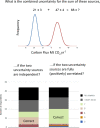Uncertainty in REDD+ carbon accounting: a survey of experts involved in REDD+ reporting
- PMID: 39068232
- PMCID: PMC11283695
- DOI: 10.1186/s13021-024-00267-z
Uncertainty in REDD+ carbon accounting: a survey of experts involved in REDD+ reporting
Abstract
Background: Reducing Emissions from Deforestation and forest Degradation (REDD+) is a program established under the United Nations Framework Convention on Climate Change (UNFCCC) to reduce carbon emissions from forests in developing countries. REDD+ uses an incentive-based approach whereby participating countries are paid to reduce forest carbon loss and increase carbon storage. Country-level carbon accounting is challenging, and estimates of uncertainty in emission reductions are increasingly required in REDD+ reports. This requirement is hard to meet if countries lack the necessary resources, tools, and capabilities. Some REDD+ programs adjust their payments for the uncertainty reported, which presents a perverse incentive because uncertainties are larger if more sources of uncertainty are reported. We surveyed people involved in REDD+ reporting to assess current capacities and barriers to improving estimates of uncertainty.
Results: Representatives from 27 countries (44% of REDD+ countries at the time of survey implementation) responded to the survey. Nearly all respondents thought it important to include uncertainty in REDD+ reports, but most felt that the uncertainty reporting by their countries was inadequate. Our independent assessment of reports by these countries to the UNFCCC supported this opinion: Most countries reported uncertainty in activity data (91%) but not in emission factors (4-14%). Few countries use more advanced approaches to estimate uncertainty, such as Monte Carlo and Bayesian techniques, and many respondents indicated that they lack expertise, knowledge, or technical assistance. Other barriers include lack of financial resources and appropriate data. Despite these limitations, nearly all respondents indicated a strong desire to improve estimates of uncertainty in REDD+ reports.
Conclusions: The survey indicated that people involved in REDD+ reporting think it highly important to improve estimates of uncertainty in forest carbon accounting. To meet this challenge, it is essential to understand the obstacles countries face in quantifying uncertainty so we can identify where best to allocate efforts and funds. Investments in training and resources are clearly needed to better quantify uncertainty and would likely have successful outcomes given the strong desire for improvement. Tracking the efficacy of programs implemented to improve estimates of uncertainty would be useful for making further refinements.
Keywords: Carbon credits; Forest carbon; REDD+; Survey; Tropical deforestation.
© 2024. The Author(s).
Conflict of interest statement
The authors declare that they have no financial or other conflicts of interest associated with this research.
Figures








References
-
- Friedlingstein P, O’Sullivan M, Jones MW, Andrew RM, Bakker DC, Hauck J, et al. Global carbon budget 2023. Earth Syst Sci Data. 2023;15(12):5301–69. 10.5194/essd-15-5301-2023.10.5194/essd-15-5301-2023 - DOI
-
- Intergovernmental Panel on Climate Change (IPCC). 2022. Climate change 2022: mitigation of climate change. Contribution of Working Group III to the Sixth Assessment Report of the Intergovernmental Panel on Climate Change. In: Shukla PR, Skea J, Slade R, Al Khourdajie A, van Diemen R, et al., editors. New York: Cambridge University Press; 2022. 10.1017/9781009157926.
-
- Harris NL, Gibbs DA, Baccini A, Birdsey RA, De Bruin S, Farina M, et al. Global maps of twenty-first century forest carbon fluxes. Nat Clim Chang. 2021;11(3):234–40. 10.1038/s41558-020-00976-6.10.1038/s41558-020-00976-6 - DOI
Grants and funding
LinkOut - more resources
Full Text Sources

